This was published 3 years ago
The rise of glamping in Australia: How do we define what 'glamping' really is?
By Julietta Jameson
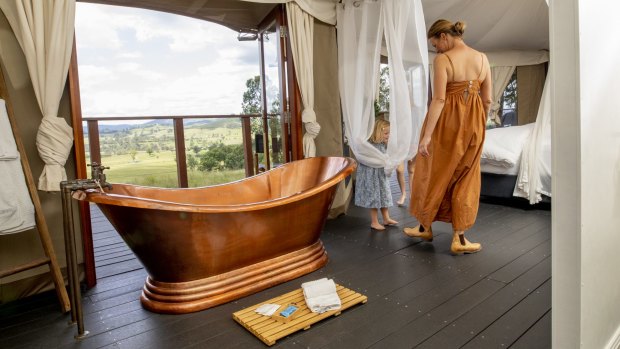
Jane Maroulis, of Boydell's in the Hunter Valley, spent 12 months planning and sourcing luxury fittings, including a copper bathtub, to furnish the genuine safari tent imported from Africa..Credit: Peter Stoop
Next time you pitch a tent in the backyard for the kids, you might want to leave it up. A man on Melbourne's Mornington Peninsula has put up a tent, called it "glamping" and is charging more than $200 a night for stays.
And judging by his Airbnb listing, people are not only paying for the privilege, but, according to most of the nearly 70 reviews, they have been enjoying themselves.
However Airbnb host John's listing, "Glamping at Mt Martha by the Beach", though active since 2017, has recently copped Twitter outrage over its set up: a basic multi-roomed tent with air beds for four on the ground, mismatched sheets, a wooden table with a couple of plastic wine goblets on it. Then there's the tent's location, right by a driveway in front of an aluminium shed in an overlooked suburban backyard, albeit one with the beach across the road.
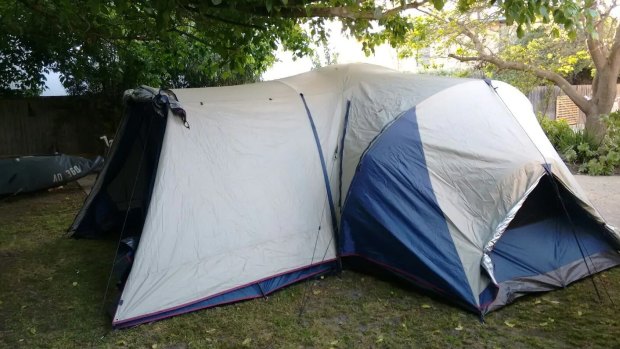
'Glamping' in Mount Martha, Victoria, as defined by one Airbnb listing.Credit: Airbnb
Tweets incredulously noted the listing boasts: "You'll have the tent to yourselves," while one tweet suggested "This is surely taking the p---."
Another brought up the question of the definition of glamping, a sentiment echoed by one of John's less flattering reviewers who said, "It certainly was not glamping but camping in a suburban backyard."
Glamping, a term that first emerged in the UK around 2006 and which entered the Oxford Dictionary in 2016, is a melding of the words "glamour" and "camping". It denotes a style of unique accommodation, often under canvas, affording access to beautiful natural locations.
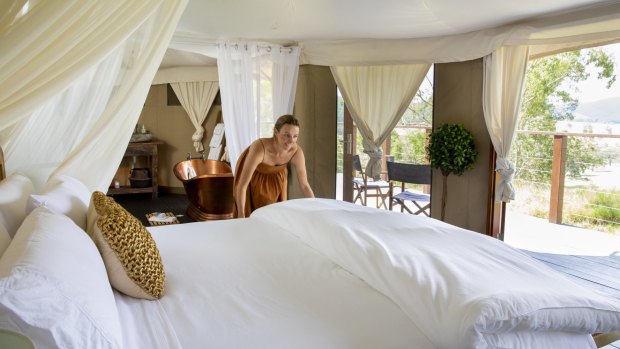
Jane Maroulis definition of glamping: "I think it's got to be a far cry from camping. You need all the creature comforts including a flushing toilet and running hot water. But then you need the added extras like we provide: beautiful sheets, a big comfy bed, toiletries, and slippers."Credit: Peter Stoop
But as Jane Maroulis, of Boydell's wines in the Hunter Valley, says, "Glamping has come to have a very loose definition. Even following the glamping hashtag on social media, you see so many variations."
Maroulis spent 12 months planning and sourcing luxury fittings, including a copper bathtub, to furnish the genuine safari tent imported from Africa she and her husband installed in the spot on their bucolic property with the best views. At $950 for two nights, her glamping experience is booked out all weekends into July.
As for her own definition: "I think it's got to be a far cry from camping. You need all the creature comforts including a flushing toilet and running hot water. But then you need the added extras like we provide: beautiful sheets, a big comfy bed, toiletries, and slippers."
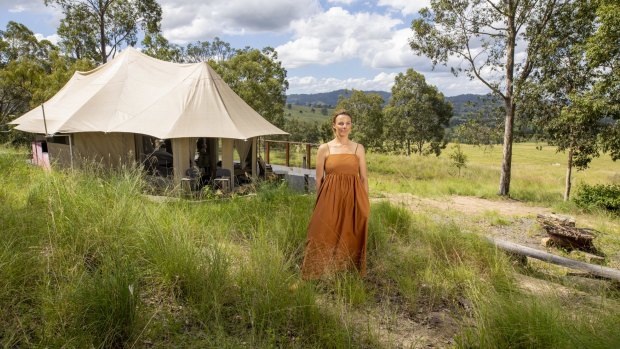
Boydell's in the Hunter Valley. At $950 for two nights, her glamping experience is booked out all weekends into July.Credit: Peter Stoop
A pre-pandemic US research report cited the global glamping market to be worth $US2.1 billion in 2018 and expected to expand annually by 12.5 per cent from 2019 to 2025.
Post-pandemic, that may be conservative for Australians, who are falling in love with domestic travel again. Executive director of the Australian Tourism Industry Council Simon Westaway, says "Our outdoors, nature and weather lends itself to this type of style of recreation."
In fact, he'd like to see more, while acknowledging his point of view is not everyone's.
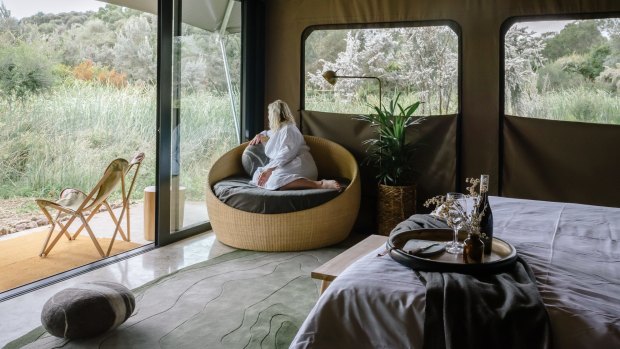
One of the new glamping tents at Peninsula Hot Springs on Victoria's Mornington Peninsula.
"One of our biggest selling points is the accessibility and appeal of our nature, flora and fauna. With the right planning arrangements, we could see this kind of accommodation in and around national parks and other areas of wilderness. It requires discussions between the tourism industry, government and community. It's not about pushing the envelope, it's about ascertaining what's possible and what's not."
Thirty kilometres along the peninsula from Mount Martha, the renowned spa property Peninsula Hot Springs recently opened 10 glamping "tents" – at a cost of around $250,000 a pop, not to mention the additional infrastructure surrounding them.
Charging $650 a night twin share, the experience includes breakfast, unlimited access to the hot springs and several exclusive experiences.
Its co-founder, Charles Davidson, believes interest in glamping will only increase in the wake of the pandemic, due to the corelation between being in enclosed places and getting the virus. His organisation is now planning a further glamping property at Metung in Victoria's East Gippsland.
"Our place is a about getting people out into nature, connection with the environment, yet it not being a big leap, because it comes with all these beautiful things: access to massages, a bottle of champagne, and hydronic heating from the springs."
Airbnb says that since 2019 (pre-pandemic) it has seen a 450 per cent increase in searches for Australian listings that include the word "tents", "yurts" or "teepees".
While not commenting on the question of whether Airbnb had any standards by which a listing could define itself as "glamping", Susan Wheeldon, Airbnb's country manager for Australia and New Zealand, said in a statement: "This trend towards glamping has meant there's never been a better time to host on Airbnb. Hosts can take something simple like a tent, barn or tiny home and in the right location with the right amenities, it can quickly become an 'in demand' Airbnb listing. In fact, six of our top 10 most wish-listed listings across Australia are classified as 'unique stays'."
Sign up for the Traveller newsletter
The latest travel news, tips and inspiration delivered to your inbox. Sign up now.